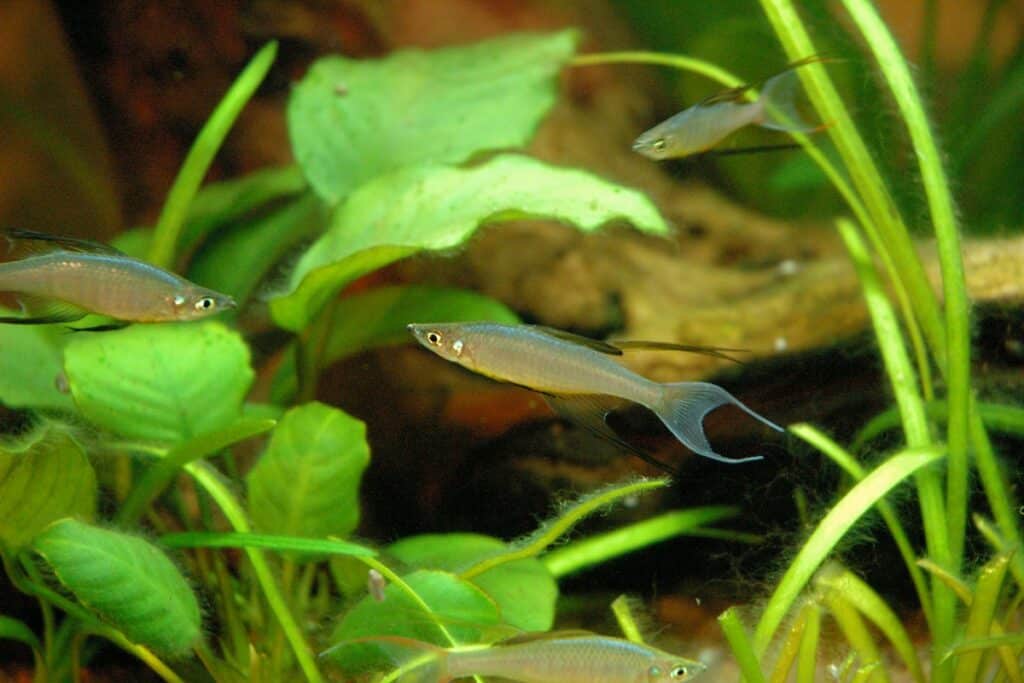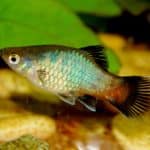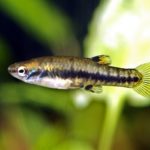Ensuring that you select the appropriate fish for your aquarium can help create a cohesive and balanced environment, while stocking your tank with incompatible species can lead to aggression and conflict.
If you want to create a tranquil, enjoyable aquarium, consider getting a Threadfin Rainbowfish. This fish is known for its docile and harmless nature. It is peaceful and enjoys being around other fish, making it the ideal candidate for a community aquarium.

Species Summary
The Threadfin Rainbowfish (Iriatherina werneri) is most often found in slow-moving waterways, swamps, and lakes in southern New Guinea and Northern Australia.
The characteristics of this fish are appreciated when composing aquariums that closely resemble its natural habitat. The youngest individuals of the species, including the females, will form large groups in plants and gnarled branches on the edges of these locations. Adult males, in turn, will frequent these locations displaying their colors in hopes of mating.
Its colors take on those of the rainbow from certain viewing angles. Overall, this fish is well-suited for any aquarium due to its striking colors and social, peaceful nature.
Threadfin Rainbowfish Care Guide
What can you do to keep a Threadfin Rainbowfish happy and healthy? Read on to find out.
Tank Size
The aquarium must have a minimum of 22 cocks for a group of 6 fish of this species. Always remember to keep the ratio of 1 male for every two females.
Tank Mates
This species is incredibly peaceful and can be kept without issue among other fish with similar temperaments.
It is ideal to keep the Rainbow Threadfin with other fish of similar size. For example, they can be kept with Rasboras, Danios, Corydoras, Oto Catfish, and shrimp.
Note that Threadfin Rainbowfish can’t stand food competition, so don’t keep it with bigger fish. Also, beware of associations with fish that can nibble its fins.
Same Species Tanks
TheThreadfin Rainbowfish is commonly used as the only species in planted aquariums because it is an intensely colored species. Keep it in groups of five or more individuals with a ratio of one male for every two females.
Water Parameters
They should be kept in tropical water, i.e., 77 to 84 F. They do well in most types of water (pH 6.0 to 8.0, GH 3 to 20).
Maintaining a pH between 6 and 7 and a temperature around 80 F is ideal for aquariums. However, it is found living mainly in its biotope conditions within the temperature and pH range.
What to Put in Their Tank
These fish naturally inhabit areas such as clear water areas, lowland swamps, drainage ditches, and slow streams with an abundance of vegetation and clear water. In clear water areas, weekly partial water changes are recommended, especially as it is susceptible to nitrates and sudden changes in pH.
The species is particularly fond of densely planted tanks; however, leaving an area open for free swimming is good. Always try to keep lots of plants like Hygrophylas and Cryptocoryne.
Decorate the tank with roots and driftwood, as these fish love to stay close to these ornaments and use them as a refuge.
The substrate can be either sandy or gravel-based. Darker substrates will bring out the fish’s radiant colors.
Common Diseases
It is quite common in the aquarium hobby for the fish’ longevity to be relatively brief, with an average of 2 to 3 years.
And remember: this fish is susceptible to fungal infections in the fins (Fin Rot) and external parasites (Ich and Flukes).
Food and Diet
The Rainbow Needlefish is an omnivorous fish that primarily feeds on crustaceans but also consumes algae and plants.
This fish is known to accept a variety of food types in an aquarium setting, including commercial pet food, dry food, live food, and fresh food. The diet for the fish should consist of either frozen or live mosquito larvae, brine shrimp, daphnia, copepods, and micro worms.
Lifespan
Quite common in the aquarium hobby, its longevity is relatively brief, with an average lifespan of 2 to 3 years.
Appearance
This rainbow fish has an elongated, fusiform body, metallic blue, with pink and yellowish-green reflections. The tail fin is lyre-shaped with a broad red border.
There are several regional variations commercially available, with New Guinea populations tending to be darker in color than Australian varieties. Some specimens from Australia have very yellow fins.
Size
They are relatively small-sized fish, males are around 1.5 inches, and adult females are smaller, approximately 1.1 inches in length.
Behavior and Temperament
Although they are typically peaceful animals, males may fight over females. Consequently, it is recommended that you keep several males and females in the same aquarium.
Their “fight” consists of a wave of fins, something beautiful to behold. However, keep a ratio of 1 male to 2 females to avoid any problems.
They are very active fish, swimming actively throughout the aquarium, feeding both mid-water and close to the substrate. They have a beautiful mating ritual, with the male fanning his beautiful flippers to attract the females.
Breeding
Breeding this rainbowfish in captivity is easy; keep the animals healthy and provide the right conditions.
To start the process, add lots of floating plants so they can lay on them.
After laying, remove the plants, as this prevents the eggs and fry from ending up in the mouths of other fish and the parents who do not have parental care. The best is to use a breeding aquarium with one male and two females.
The male vibrates his upright fins to invite the females to spawn on the plants. A few eggs are laid each day, scattered among the thin-leaved plants.
After fertilizing, the eggs hatch in 8 to 12 days. Fry is challenging to feed because of their tiny mouths; they are among the smallest fingerling species among the different ornamental freshwater fish. For this reason, provide microalgae or infusoria.
If you look closely, you’ll see them swimming around the water’s surface. They will need infusoria, and this food will need to last at least 7-10 days before their small mouths can handle micro worms or nauplii.
The fingerlings grow very fast, reaching about 2 cm in 2 months.
Gender Differences: Male vs Female
The male of the species has a large and colorful dorsal fin compared to the female. Another characteristic that demonstrates sexual dimorphism is length, with males averaging 1.5 inches and females only 1.1.
Threadfin Rainbowfish Fun Facts
- Although it belongs to the Melanotaenidae family, its body differs significantly from the species of this family.
- Several scientists study the size of male fins about energy expenditure for swimming and its hydrodynamics.
References
Allen, G.R., S.H. Midgley and M. Allen, 2002. Field guide to the freshwater fishes of Australia. Western Australian Museum, Perth, Western Australia. 394 p.
Baensch, H.A. and R. Riehl, 1985. Aquarien atlas. Band 2. Mergus, Verlag für Natur-und Heimtierkunde GmbH, Melle, Germany. 1216 p.
FAO-FIES, 2015. Aquatic Sciences and Fisheries Information System (ASFIS) species list. Retrieved from http://www.fao.org/fishery/collection/asfis/en, [accessed 13/04/2015].
llen, G.R., 1989. Freshwater fishes of Australia. T.F.H. Pu








